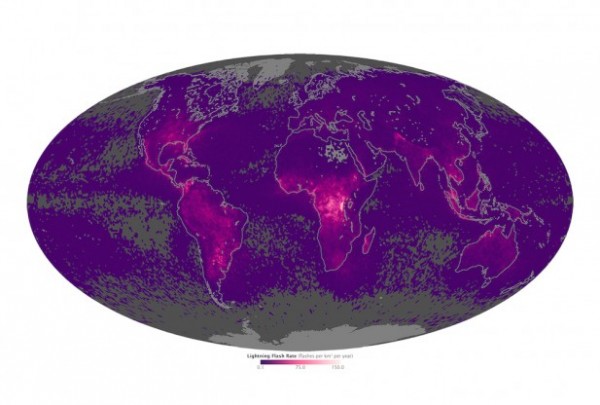Where in the World Does Lightning Strike Most? NASA Reveals New Global Lightning Map
| Ana Verayo | | Apr 07, 2015 08:02 AM EDT |
(Photo : NASA) Central Africa and north western South America are plagued by the most lightning strikes in the world.
A new map compiled by NASA shows regions located in the equator or near this region are most likely to experience lightning strikes.
The space agency mapped lightning strike occurrences across the globe using data obtained from 1998 to 2003 by NASA's Tropical Rainfall Measuring Mission satellite via its Lightning Imaging Sensor (LIS) and the Optical Transient Detector (OTD) found aboard the OrbView-1/Microlab satellite.
Like Us on Facebook
The data showed lightning in general was most likely to strike on land than on water since rock solid earth can absorb more heat from the Sun and becomes hotter much faster than water. This generates a stronger convection and atmospheric instability over land and normally leads to precipitation forming into storms accompanied by thunder and lightning.
Scientists from NASA also learned some regions have some unusual trends when it comes to lightning. There's a high occurrence of lightning in the Brahmaputra Valley in eastern India during the month of May. The valley experiences irregular heating and weather patterns from the onslaught of the upcoming monsoon leads to a significant amount of rain and fewer lightning strikes.
Regions that experience most lightning storms, however, are apparently located in central Africa and northwest South America where lightning occurs during the entire year.
The map also reveals the regions in the world with the most lightning storms is apparently located in the Congo in Africa and Lake Maracaibo in Venezuela where a whopping 300 nights per year are plagued by lightning strikes.
NASA's TRMM satellite is a joint project with the Japan Aerospace Exploration Agency (JAXA) and is specifically designed to measure any amount of rainfall for weather and climate research. The main focus of the mission is to further understand how rainfall is distributed and determine the variability of precipitation in tropical regions around the globe that is pivotal to the world's climate system and water cycle.
On the other hand, the OrbView-1/Microlab is an imaging satellite that captures high resolution images of Earth. Its OTD instrument records the number of flashes from lightning strikes and measures their intensity along with the time and location of the strike.
TagsWhere in the World Do Lightning Strike Most? NASA Reveals New Global Lightning Map, NASA, lightning, new map NASA lightning, lightning strikes world
©2015 Chinatopix All rights reserved. Do not reproduce without permission
EDITOR'S PICKS
-

Did the Trump administration just announce plans for a trade war with ‘hostile’ China and Russia?
-

US Senate passes Taiwan travel bill slammed by China
-

As Yan Sihong’s family grieves, here are other Chinese students who went missing abroad. Some have never been found
-

Beijing blasts Western critics who ‘smear China’ with the term sharp power
-

China Envoy Seeks to Defuse Tensions With U.S. as a Trade War Brews
-

Singapore's Deputy PM Provides Bitcoin Vote of Confidence Amid China's Blanket Bans
-

China warns investors over risks in overseas virtual currency trading
-

Chinese government most trustworthy: survey
-

Kashima Antlers On Course For Back-To-Back Titles
MOST POPULAR
LATEST NEWS
Zhou Yongkang: China's Former Security Chief Sentenced to Life in Prison

China's former Chief of the Ministry of Public Security, Zhou Yongkang, has been given a life sentence after he was found guilty of abusing his office, bribery and deliberately ... Full Article
TRENDING STORY

China Pork Prices Expected to Stabilize As The Supplies Recover

Elephone P9000 Smartphone is now on Sale on Amazon India

There's a Big Chance Cliffhangers Won't Still Be Resolved When Grey's Anatomy Season 13 Returns

Supreme Court Ruled on Samsung vs Apple Dispute for Patent Infringement

Microsoft Surface Pro 5 Rumors and Release Date: What is the Latest?










